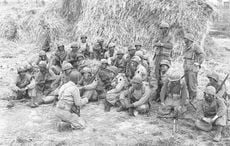The debate over the existence of No Irish Need Apply (NINA) signs and advertisements has resurfaced once again in the Letters Pages of UK newspaper The Guardian.
On October 21, The Guardian reader John Draper wrote to the paper claiming that there was no proof to suggest that NINA signs ever appeared in any place in the UK but in the imagination of Irish activists living there.
Many have responded to his claims, also writing to the Letters Pages to share their own experience of being Irish in England and facing these signs while looking for accommodation, once again opening up the debate on whether NINA signs are historical fact or a collective imagined memory of Irish living abroad.
“In the 1980s, Irish activists asserted that ‘No Irish, no blacks, no dogs’ had been widespread,” Draper writes, “but there is no evidence for such signs in any British or Irish archive (they were not, for example, mentioned in parliament during the 1960s race relations debates nor by TDs in Dáil Éireann [Irish parliament]).”
Draper claims that recent proposals on immigration from the British government have caused a resurgence in this myth, despite what he calls dubious evidence as to their existence.
He cites one example, in particular, of a handwritten sign in a Bed and Breakfast window reading “No Irish, no blacks, no dogs,” a photograph of which is now held in the Irish Studies Centre of London Metropolitan University.
He remains cynical of the authenticity of this photograph, however, stating that the university “has conceded to me that it is of ‘somewhat uncertain’ provenance. They have been unable to discover who took the picture, where or when.”
READ MORE: No such thing as "No Irish Need Apply" signs argues historian.
Draper continues to say that although many claim to have seen NINA signs in the past, they are fooled by the endless circulation of the same image from the University and are, in fact, all remembering the exact same sign, a problem he feels has been worsened with the spread of the image on the Internet.
Other readers quickly replied to Draper’s letter with their own, citing their personal experiences or the experiences of their family as proof that NINA signs were once in existence in the UK.
“My late English mother and Caribbean father who married in the 1950s vividly recalled signs advertising flats to let with the proviso ‘no blacks, no Irish, no dogs,’” wrote Gavin Lewis on October 22.
“They weren’t Irish so had no reason to arbitrarily include themselves as victims.”
“When I was searching for a room in London in 1957, notices saying ‘No coloured, no Irish, no children’ were everywhere. As I had an Irish husband and a baby I was doubly barred,” Diana Payan followed while Adrian Jennings claimed, “I suspect that Mr Draper is confusing different eras of prejudice. My father, who died in 1971, remembered ‘No Irish, no dogs’ signs in Old Trafford in the 1930s. There were very few black people in Manchester at that time.”
On October 25, Lorraine Fannin claimed that the NINA signs were also still in existence in the 1960s.
She told her own story to The Guardian as a student from Belfast attending Reading University in 1966.
“I was upset and insulted to find notices galore that said ‘No Irish, no coloureds,’” she revealed.
“I was so indignant that I took a photo and sent it with a covering note to the Belfast Telegraph.
“I also brought it up at the university, where they tried to soothe me with the explanation that it really referred to the rather ‘rough Irish navvies’ who were then working on the many building sites around the Thames Valley.”
In his letter of refute on October 22, Patrick Reynolds comments that Draper’s arguments mirror those of Professor Richard Jenson, author of “No Irish Need Apply: A Myth of Victimization” (2002), who achieved notoriety this summer when his paper was disproved by a 14-year old American student, Rebecca Fried.
As reported by IrishCentral, despite the evidence unearthed by Fried, and 1,4000 examples of “No Irish Need Apply” advertisements discovered by IrishCentral readers, Professor Richard Jenson still claims that such signs rarely existed, referring to them as the “NINA legend”.
Earlier this year, 8th grade student Rebecca Fried published “No Irish Need Deny: Evidence for the Historicity of NINA Restrictions in Advertisements and Signs” in the summer edition of the Oxford Journal of Social History, claiming to have disproven the theory of Professor Richard Jensen that there was no such thing as the “No Irish Need Apply” signs.
READ MORE: Amazing 8th-grader explains how she proved No Irish Need Apply signs existed.
Her article was a response to a 2002 article published in the same journal by Jensen, a retired Professor of History at the University of Illinois, Chicago, entitled “’No Irish Need Apply’: A Myth of Victimization” which claimed the signs were a fabricated memory of Irish-Americans to make themselves appear as victims.
Following Fried’s discovery, IrishCentral readers carried out their own research sending in their proof to us to further disprove Jensen.
Our own investigation of Newspapers.com alone returned over 1,400 mentions of “No Irish Need Apply” in newspapers throughout the US between 1828 and 2012 , peaking during the years 1873 to 1883 with 400 examples.
Among the numerous readers examples submitted was evidence from Barry Popik, a New York etymologist who has extensively catalogued examples of “No Irish Need Apply” on his own website, discovering cases as far back as the 1700s.
Kathleen O’Nan from Chicago also commented that her father often told of signs being common when he was a young man in the 1930s and had himself a “photograph from a meat-packing plant that said ‘Colored and Irish Need Not Apply.’"
Why do you think the debate over the existence of NINA signs and advertisements continues? Why has it become so important to prove or disprove? Leave your thoughts in the comments section.




Comments